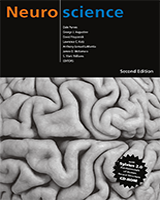By agreement with the publisher, this book is accessible by the search feature, but cannot be browsed.
NCBI Bookshelf. A service of the National Library of Medicine, National Institutes of Health.
Purves D, Augustine GJ, Fitzpatrick D, et al., editors. Neuroscience. 2nd edition. Sunderland (MA): Sinauer Associates; 2001.

Neuroscience. 2nd edition.
Show detailsA complex mosaic of interconnected frontal lobe areas that lie rostral to the primary motor cortex also contributes importantly to motor functions (see Figure 17.7). The upper motor neurons in this premotor cortex influence motor behavior both through extensive reciprocal connections with the primary motor cortex, and directly via axons that project through the corticobulbar and corticospinal pathways to influence local circuit and lower motor neurons of the brainstem and spinal cord. Indeed, over 30% of the axons in the corticospinal tract arise from neurons in the premotor cortex. In general, a variety of experiments indicate that the premotor cortex uses information from other cortical regions to select movements appropriate to the context of the action (see Chapter 26).
The functions of the premotor cortex are usually considered in terms of the lateral and medial components of this region. As many as 65% of the neurons in the lateral premotor cortex have responses that are linked in time to the occurrence of movements; as in the primary motor area, many of these cells fire most strongly in association with movements made in a specific direction. However, these neurons are especially important in conditional motor tasks. Thus, in contrast to the neurons in the primary motor area, when a monkey is trained to reach in different directions in response to a visual cue, the appropriately tuned lateral premotor neurons begin to fire at the appearance of the cue, well before the monkey receives a signal to actually make the movement. As the animal learns to associate a new visual cue with the movement, appropriately tuned neurons begin to increase their rate of discharge in the interval between the cue and the onset of the signal to perform the movement. Rather than directly commanding the initiation of a movement, these neurons appear to encode the monkey's intention to perform a particular movement; thus, they seem to be particularly involved in the selection of movements based on external events.
Further evidence that the lateral premotor area is concerned with movement selection comes from studies of the effects of cortical damage on motor behavior. Lesions in this region severely impair the ability of monkeys to perform visually cued conditional tasks, even though they can still respond to the visual stimulus and can perform the same movement in a different setting. Similarly, patients with frontal lobe damage have difficulty learning to select a particular movement to be performed in response to a visual cue, even though they understand the instructions and can perform the movements. Individuals with lesions in the premotor cortex may also have difficulty performing movements in response to verbal commands.
The medial premotor cortex, like the lateral area, mediates the selection of movements. However, this region appears to be specialized for initiating movements specified by internal rather than external cues. In contrast to lesions in the lateral premotor area, removal of the medial premotor area in a monkey reduces the number of self-initiated or “spontaneous” movements the animal makes, whereas the ability to execute movements in response to external cues remains largely intact. Imaging studies suggest that this cortical region in humans functions in much the same way. For example, PET scans show that the medial region of the premotor cortex is activated when the subjects perform motor sequences from memory (i.e., without relying on an external instruction). In accord with this evidence, single unit recordings in monkeys indicate that many neurons in the medial premotor cortex begin to discharge one or two seconds before the onset of a self-initiated movement.
In summary, both the lateral and medial areas of the premotor cortex are intimately involved in selecting a specific movement or sequence of movements from the repertoire of possible movements. The function of the areas differs, however, in the relative contributions of external and internal cues to the selection process.
- The Premotor Cortex - NeuroscienceThe Premotor Cortex - Neuroscience
- photosystem I P700 chlorophyll A apoprotein A1, partial (plastid) [Pterocladiell...photosystem I P700 chlorophyll A apoprotein A1, partial (plastid) [Pterocladiella beachiae]gi|1000356233|gb|AML28797.1|Protein
- photosystem I P700 chlorophyll A apoprotein A1, partial (plastid) [Gelidiella in...photosystem I P700 chlorophyll A apoprotein A1, partial (plastid) [Gelidiella incrassata]gi|1000356221|gb|AML28791.1|Protein
- photosystem I P700 chlorophyll A apoprotein A1, partial (plastid) [Gelidium oman...photosystem I P700 chlorophyll A apoprotein A1, partial (plastid) [Gelidium omanense]gi|1000356203|gb|AML28782.1|Protein
- photosystem I P700 chlorophyll A apoprotein A1, partial (plastid) [Gelidiella li...photosystem I P700 chlorophyll A apoprotein A1, partial (plastid) [Gelidiella ligulata]gi|1000356223|gb|AML28792.1|Protein
Your browsing activity is empty.
Activity recording is turned off.
See more...